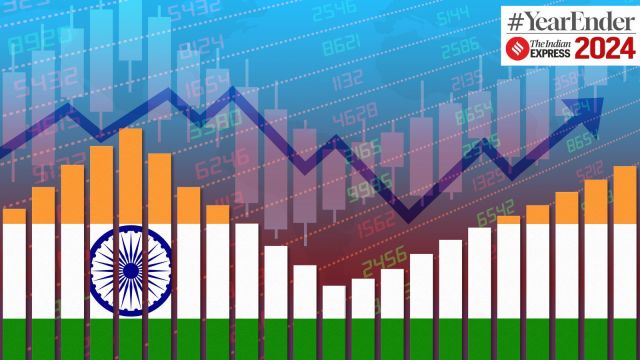Despite facing high inflation and global uncertainties, the Indian economy demonstrated remarkable resilience in 2024, characterised by strong GDP growth, substantial foreign exchange reserves, and record levels of foreign direct investment (FDI) inflows.

Additionally, it is also currently the third-largest economy in the world in terms of GDP based on purchasing power parity (PPP) with a GDP size of 16.02 trillion USD, as per the IMF’s recent data, trailing behind China and the US.
 An outlook of India’s GDP (current prices in US$, billion) over the years | Source: IMF
An outlook of India’s GDP (current prices in US$, billion) over the years | Source: IMF
With it being on a fast track to become the third-largest economy in terms of real GDP by 2030, the World Bank recently projected that India’s growth will reach 7 per cent in FY 2024-25 and remain robust in FY 2025-26 and FY 2026-27.
As India continues to strengthen its economic foundation to maintain its status as a key player on the global stage, it has been ranked on various international indexes based on different economic indicators to provide a comprehensive view of its overall economic performance beyond GDP.
Let’s take a closer look at India’s rankings across multiple economic pillars in 2024, highlighting both achievements and areas for improvement.
Story continues below this ad
Where did India rank on global economic-related indexes in 2024?
India’s performance across various economic indexes in 2024 presents a complex narrative of progress intertwined with persistent challenges.
While it emerges as a significant player on the world stage, characterised by strong GDP growth metrics, the development of cities, and the wealth of certain states, it continues to grapple with issues like low labour productivity, employment rates, and more.
The following table summarizes India’s performance across key global economic indexes for 2024:
India’s rising status as a ‘Global Superpower’:
Looking at its economic outlook, India presently is in a highly favourable position, with a low debt burden and strong projected real growth over the next ten years (6.3% per year), leading it to transform into a global superpower in the upcoming decade, as forecasted in Ray Dalio’s Great Powers Index 2024.
Story continues below this ad
Its ascent is increasingly evident through its significant investments in infrastructure and military spending, with these two pillars crucial for enhancing its global standing and ensuring national security.
According to Savills Research, four Indian cities have been recognized as the fastest-developing cities, with Bengaluru identified as the fastest-developing city globally, followed by Delhi, Hyderabad, and Mumbai, which are also in the top five.
Rising wealth creation and billionaires in India:
India is experiencing a remarkable surge in wealth creation, boasting a collective billionaire wealth of approximately US$ 1 trillion, accounting for 7% of the world’s total wealth, leading to Mumbai recently surpassing Beijing as the ‘Billionaire Capital’ of the world.
Story continues below this ad
In addition to being home to billionaires like Mukesh Ambani and Gautam Adani, India is also witnessing substantial growth in its millionaire population, according to the Hurun Report for 2024.
Welcoming 94 new billionaires this year—the highest increase in billionaires globally, after the US and China, this brings the total count of Indian billionaires to 271, positioning the nation in third place for the most millionaires worldwide, as per Forbes.
Furthermore, the UBS Global Wealth Report 2024 highlights India’s promising outlook, ranking it 11th among nations with the fastest-growing millionaire populations, with an anticipated growth rate of 22% over the next five years.
Employment outlook and labour productivity:
As the Indian economy is largely driven by its skilled workforce, in a notable shift, this year, its employment landscape has witnessed a historic shift, witnessing a total of seven crore job applications, which is a 25 per cent year-on-year surge, according to a recent report.
Story continues below this ad
Despite this, India’s employment-to-population ratio stands at 52.8%, accompanied by a labour dependency ratio of 1.52, indicating that a significant portion of the population remains outside the labour force.
ILOSAT additionally highlights that the labour productivity in India, in terms of GDP per hour worked, is also quite low, estimated at $8, leading India to stand at 133rd globally.
 India is ranked 13th among the world’s most overworked countries, with workers logging some of the longest hours.
India is ranked 13th among the world’s most overworked countries, with workers logging some of the longest hours.
This is because an average Indian worker works 46.7 hours each week, with 51 per cent of India’s workforce working 49 or more hours each week, ranking India second among countries with the highest rates of prolonged working hours, according to the International Labour Organisation.
With India continuing to position itself as a significant global superpower in the coming years, focusing on its growth trajectory while addressing these challenges will be crucial for sustaining its economic momentum and enhancing overall living standards for its population.



 An outlook of India’s GDP (current prices in US$, billion) over the years | Source: IMF
An outlook of India’s GDP (current prices in US$, billion) over the years | Source: IMF India is ranked 13th among the world’s most overworked countries, with workers logging some of the longest hours.
India is ranked 13th among the world’s most overworked countries, with workers logging some of the longest hours.





























